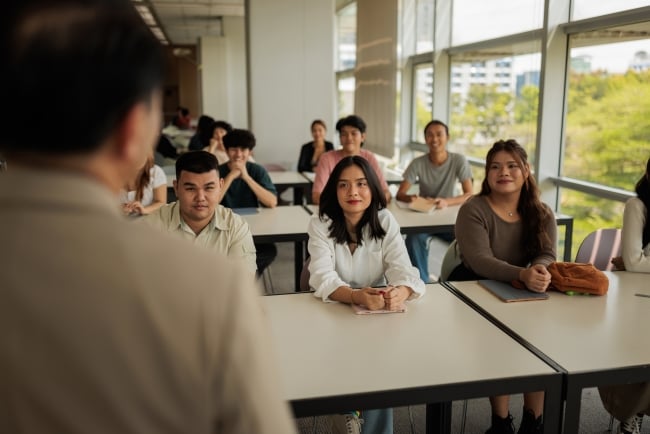You have /5 articles left.
Sign up for a free account or log in.

With the continuing influx of international students into the United States, pedagogical practices have become more diverse and enriched by the educational traditions those students bring to the classroom. That diversity can inspire new and productive insights for how we teach our classes. In this essay, I’d like to share some lessons that I learned along those lines when I designed and taught an academic writing course specifically for Chinese-speaking international students.
As the designer of and primary instructor for the class, I helped conduct surveys among faculty members to identify and address any issues they had about teaching international students. One notable comment we often heard concerned the challenges the faculty had engaging international students in class discussions. When we surveyed students, however, they primarily expressed concerns about improving their English proficiency in their writing.
At the time, I primarily taught my classes through lectures rather than discussions and group work, or what are often considered active learning strategies. Inevitably, my Chinese educational background has influenced my emphasis on lectures, which is frequently characterized by expository teaching. Many teachers in China typically expect students to grasp foundational knowledge through attentive listening, a method often perceived as didactic, with students cast in passive roles as mere recipients of information. Of course, this approach is certainly not limited to Chinese classrooms, as lectures remain a prevalent instructional mode in the United States as well.
I’ve observed that even though my Chinese students may sometimes express a bit of dissatisfaction with learning through lectures—considering it somewhat of an old-school approach prevalent in their middle schools in China—they fundamentally find this method effective and accept it in classroom reality. I’ve found that they also tend to outperform students who are not taught primarily through lectures. It appears that this traditional way of learning must still have some validity. So despite the fact that various pedagogical experts and instructors criticize traditional lectures as being too passive and old-fashioned, I’d like to outline some specific justifications for using them—especially with international students—drawing not only from the Chinese educational tradition, but also from common-sense insights across various cultures.
Lectures have proved to be a more informative and efficient method of class delivery. In comparison with discussions, lectures are straightforward and can convey more factual information within an equal length of time. (Consider this: You can explain a greater number of new vocabulary terms in 30 minutes during a lecture, whereas you will probably be able to discuss far fewer words in the same time frame during a discussion.) This informative and efficient delivery method proves to be a shared value that can appeal to students from different cultural backgrounds around the world.
Lectures require significant input from the instructors. Behind their success lie the substantial time and effort the teachers must invest, as they must have an in-depth grasp of the subject matter and be fully prepared each time they teach this way. In contrast, discussions can be perceived as shifting the burden from the speaker to the audience, although their primary aim is to engage students with the subject and uncover new insights. (Imagine the disappointment of an audience expecting to learn from the speaker, only to hear them say, “All right, my presentation is mostly open-ended. Now, I’ll divide you into groups to discuss the topic.”)
Lectures involve fewer risks and demands. One reason why international students often prefer lectures over discussions is because lectures offer a lower level of risk and fewer demands compared to discussions. Although student-centered discussions may seem appealing, in classroom practice, you may find even domestic students often prefer teacher-centered lectures where they can comfortably listen to the instructor. Additionally, international students encounter more linguistic and cultural challenges and often experience greater difficulties in simply expressing themselves during classroom discussions.
Therefore, in comparison to the linguistic and cultural challenges inherent in lengthy discussions, well-structured lectures often provide a safer and more inclusive learning format for international students, offering them a more manageable and effective learning experience. This may also be true for domestic students, as they too sometimes resist active-learning pedagogies.
These justifications for traditional lectures stem from common sense as well as illustrate how different teaching cultures can inform each other. I do not intend to diminish the importance of discussions, which are proven to be effective in engaging students with the subject matter and fostering their problem-solving skills. Specifically, discussions play a crucial role in gathering diverse perspectives from international students’ lived experiences, all of which are essential values in cross-cultural teaching. However, classroom reality often differs from a perfect world, requiring significant effort to facilitate truly productive discussions.
Therefore, I often found myself pursuing a balance between lectures and discussions based on the specific class content and student demographics. One day, for example, I began to teach students how to develop a promising research topic. We started with a 10-minute freewriting session to brainstorm tentative research topics. Following this, I presented some sample topics from student academic conferences and asked those in the class to compare such samples with their own ideas. I noticed their eyes light up when comparing their broad global warming topics with more specific ones like “Michigan’s water-level sensors in Oakland County.”
While I recognized it was the right moment to initiate a 10-minute discussion on this comparison, it naturally steered into a 30-minute formal lecture. And it was clear to me that after all those lead-in exercises, the lecture would be more understandable and engaging for international students.
In other words, I’ve developed relevant strategies to enhance the engagement and accessibility of my lectures. Again, I found that those strategies, which I’ve listed below, demonstrate shared values across different cultures and have universal appeal to both domestic and international students.
- Emphasize students’ cognitive processes. Lecturing doesn’t entail talking nonstop for hours. Instead, I often incorporate relevant puzzle-solving activities—such as brief, structured discussions—before lectures to enhance students’ comprehension. I also conclude the teaching session with videos on relevant topics to deepen students’ understanding of the lecture. And I consistently emphasize the construction of a coherent sequence of the class to make it a smooth flow of conversation with students.
- Create an accessible conversational atmosphere. Informal conversations prove invaluable for international students, who are often grappling with not only abstract discussions but the complexities of a new and unfamiliar language. I often found myself walking around and trying to talk to students amiably, like a friend. In my course on academic writing, rather than stating something like “Writing is an epistemic and recursive process,” I often ask questions, such as “How many drafts do you typically go through before submitting your final paper?” I firmly believe that these personalized conversations are essential to make the lectures more accessible. They also alleviate international students’ anxiety about various challenges in academic writing, including improving language proficiency, mastering academic language, understanding the structure and organization of academic papers, and so forth.
- Tailor course materials to the context. Instead of relying heavily on analytical worksheets to develop students’ ideas, as many of my American colleagues often do, I tend to use more holistic writing samples to illustrate key points. I find this traditional method more approachable and effective for international students. Accordingly, I carefully select course materials that are relatable to international students to enhance their engagement with the lectures. That often involves starting with short TED Talk videos, followed by a review of relevant background knowledge online, before delving into lectures on formal academic papers.
- Prioritizing practical concerns. International students often prioritize pragmatic and fundamental concerns, such as language proficiency, as the “real stuff” in their eyes. I once heard an anecdote about an international student seeking assistance with his paper at the writing center. When the tutor began discussing the paper’s content, the student interrupted, saying, “Please, sir. There are only 10 minutes left. Let’s focus on grammar.” Therefore, I prioritize addressing such practical aspects in my lectures, as these realistic concerns universally resonate with students from different cultures.
In fact, all the strategies that I’ve described address practical student concerns that are rooted in common experiences, serving as a universal language that transcends cultural differences and appeals to students from various countries. In this sense, the course itself prompted a cultural response that revealed shared values across different nations.
Correspondingly, I hope what I’ve shared from my international engagement encourages faculty members who teach mainstream writing classes to reconsider the value of various teaching practices like the traditional lecture, which may have been largely omitted in one culture but is still practiced in another. Doing so will actually enrich the mainstream curriculum and enhance pedagogical diversity.








